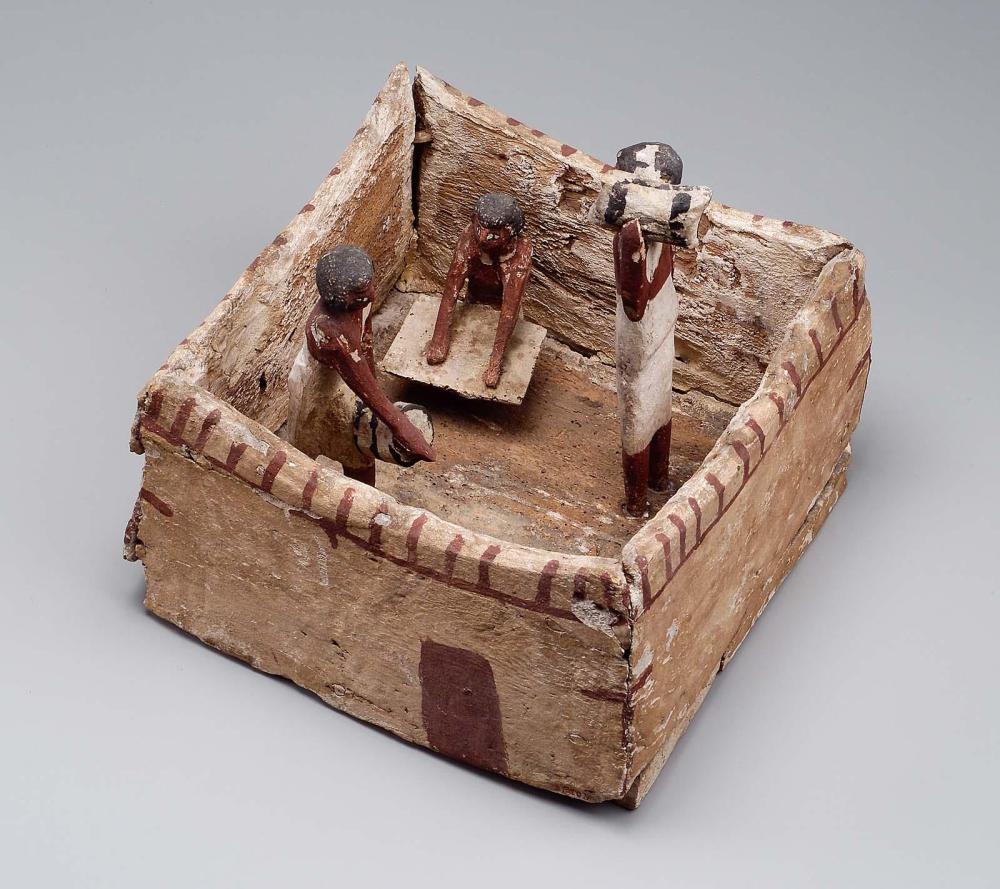Advanced Search 

Model of a granary
Egyptian
Middle Kingdom, late Dynasty 11 – early Dynasty
2010–1961 B.C.
Findspot: Egypt, Deir el-Bersha, Tomb 10, shaft A (Djehutynakht)
Medium/Technique
Wood
Dimensions
Length x width x height: 29 x 28.5 x 27 cm (11 7/16 x 11 1/4 x 10 5/8 in.)
Credit Line
Harvard University—Boston Museum of Fine Arts Expedition
Accession Number21.409
CollectionsAncient Egypt, Nubia and the Near East
ClassificationsModels
DescriptionWhile late Old Kingdom tombs had included limestone statuettes of people engaged in chores such as food preparation, a new development occurred during the First Intermediate Period and Middle Kingdom. Now, models made of wood, a less costly material, were manufactured in large numbers and placed in the burial chamber to furnish provisions for the deceased in the afterlife. In symbolically providing for the tomb owner's needs, the models functioned in much the same way as painted scenes of these activities did on the walls of tomb chapels.
The tomb of Djehutynakht contained what may be the largest collection of wooden models ever discovered in Egypt. At least thirty-nine of them, including this one, represent scenes of food production and crafts. Upon opening the tomb, however, archaeologists discovered that robbers had ransacked it in antiquity, possibly on more than one occasion, throwing the models haphazardly around the small burial chamber. Only through years of research and restoration are they being returned to their original configuration. The models vary greatly in quality, and many of them were mounted on pieces of wood recycled by the artists from old boxes or chests. The colorfully painted figures nevertheless convey a liveliness and energy that give us a sense of the bustling activities of Egyptian daily life. They also demonstrate innovative poses and subjects that would never have been attempted in the more formal sculptures that represented the tomb owner and his family.
Food production is the dominant theme among the model scenes, and a variety of activities are represented. The most common scene shows a group of three men at work in a granary building. Grain was the basic unit of wealth and exchange in ancient Egypt, and careful accounting of the crop was essential. Thus, in each granary we see one man carrying a filled sack, while another bends down to measure grain into a bucket, and a seated scribe records the quantity on a board held across his knees. Much of this grain was destined for the production of bread and beer, staples of the Egyptian diet.
Toward the end of Dynasty 12 a change occurred in Egyptian burial customs for reasons that remain unclear. Although model boats continued to be placed in tombs, the scenes of crafts and food production disappeared permanently from the repertoire of funerary offerings. At approximately the same time, early versions of shawabtys, mummiform figurines intended to serve on behalf of the deceased in the afterlife, began to become more common in burials.
The tomb of Djehutynakht contained what may be the largest collection of wooden models ever discovered in Egypt. At least thirty-nine of them, including this one, represent scenes of food production and crafts. Upon opening the tomb, however, archaeologists discovered that robbers had ransacked it in antiquity, possibly on more than one occasion, throwing the models haphazardly around the small burial chamber. Only through years of research and restoration are they being returned to their original configuration. The models vary greatly in quality, and many of them were mounted on pieces of wood recycled by the artists from old boxes or chests. The colorfully painted figures nevertheless convey a liveliness and energy that give us a sense of the bustling activities of Egyptian daily life. They also demonstrate innovative poses and subjects that would never have been attempted in the more formal sculptures that represented the tomb owner and his family.
Food production is the dominant theme among the model scenes, and a variety of activities are represented. The most common scene shows a group of three men at work in a granary building. Grain was the basic unit of wealth and exchange in ancient Egypt, and careful accounting of the crop was essential. Thus, in each granary we see one man carrying a filled sack, while another bends down to measure grain into a bucket, and a seated scribe records the quantity on a board held across his knees. Much of this grain was destined for the production of bread and beer, staples of the Egyptian diet.
Toward the end of Dynasty 12 a change occurred in Egyptian burial customs for reasons that remain unclear. Although model boats continued to be placed in tombs, the scenes of crafts and food production disappeared permanently from the repertoire of funerary offerings. At approximately the same time, early versions of shawabtys, mummiform figurines intended to serve on behalf of the deceased in the afterlife, began to become more common in burials.
ProvenanceFrom Deir el-Bersha, tomb 10, shaft A (tomb of Djehutynakht). May 1915: excavated by the Harvard University–Boston Museum of Fine Arts Expedition; assigned to the MFA in the division of finds by the government of Egypt. (Accession Date: March 1, 1921)
